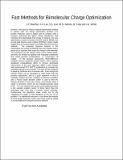| dc.contributor.author | Bardhan, Jaydeep P. | |
| dc.contributor.author | Lee, J.H. | |
| dc.contributor.author | Kuo, Shihhsien | |
| dc.contributor.author | Altman, Michael D. | |
| dc.contributor.author | Tidor, Bruce | |
| dc.contributor.author | White, Jacob K. | |
| dc.date.accessioned | 2003-11-19T21:11:40Z | |
| dc.date.available | 2003-11-19T21:11:40Z | |
| dc.date.issued | 2003-01 | |
| dc.identifier.uri | http://hdl.handle.net/1721.1/3711 | |
| dc.description.abstract | We report a Hessian-implicit optimization method to quickly solve the charge optimization problem over protein molecules: given a ligand and its complex with a receptor, determine the ligand charge distribution that minimizes the electrostatic free energy of binding. The new optimization couples boundary element method (BEM) and primal-dual interior point method (PDIPM); initial results suggest that the method scales much better than the previous methods. The quadratic objective function is the electrostatic free energy of binding where the Hessian matrix serves as an operator that maps the charge to the potential. The unknowns are the charge values at the charge points, and they are limited by equality and inequality constraints that model physical considerations, i.e. conservation of charge. In the previous approaches, finite-difference method is used to model the Hessian matrix, which requires significant computational effort to remove grid-based inaccuracies. In the novel approach, BEM is used instead, with precorrected FFT (pFFT) acceleration to compute the potential induced by the charges. This part will be explained in detail by Shihhsien Kuo in another talk. Even though the Hessian matrix can be calculated an order faster than the previous approaches, still it is quite expensive to find it explicitly. Instead, the KKT condition is solved by a PDIPM, and a Krylov based iterative solver is used to find the Newton direction at each step. Hence, only Hessian times a vector is necessary, which can be evaluated quickly using pFFT. The new method with proper preconditioning solves a 500 variable problem nearly 10 times faster than the techniques that must find a Hessian matrix explicitly. Furthermore, the algorithm scales nicely due to the robustness in number of IPM iterations to the size of the problem. The significant reduction in cost allows the analysis of much larger molecular system than those could be solved in a reasonable time using the previous methods. | en |
| dc.description.sponsorship | Singapore-MIT Alliance (SMA) | en |
| dc.format.extent | 12188 bytes | |
| dc.format.mimetype | application/pdf | |
| dc.language.iso | en_US | |
| dc.relation.ispartofseries | High Performance Computation for Engineered Systems (HPCES); | |
| dc.subject | Hessian-implicit optimization | en |
| dc.subject | bimolecular charge optimization | en |
| dc.subject | boundary element method | en |
| dc.subject | primal-dual interior point method | en |
| dc.subject | Krylov based iterative solver | en |
| dc.title | Fast Methods for Bimolecular Charge Optimization | en |
| dc.type | Article | en |
